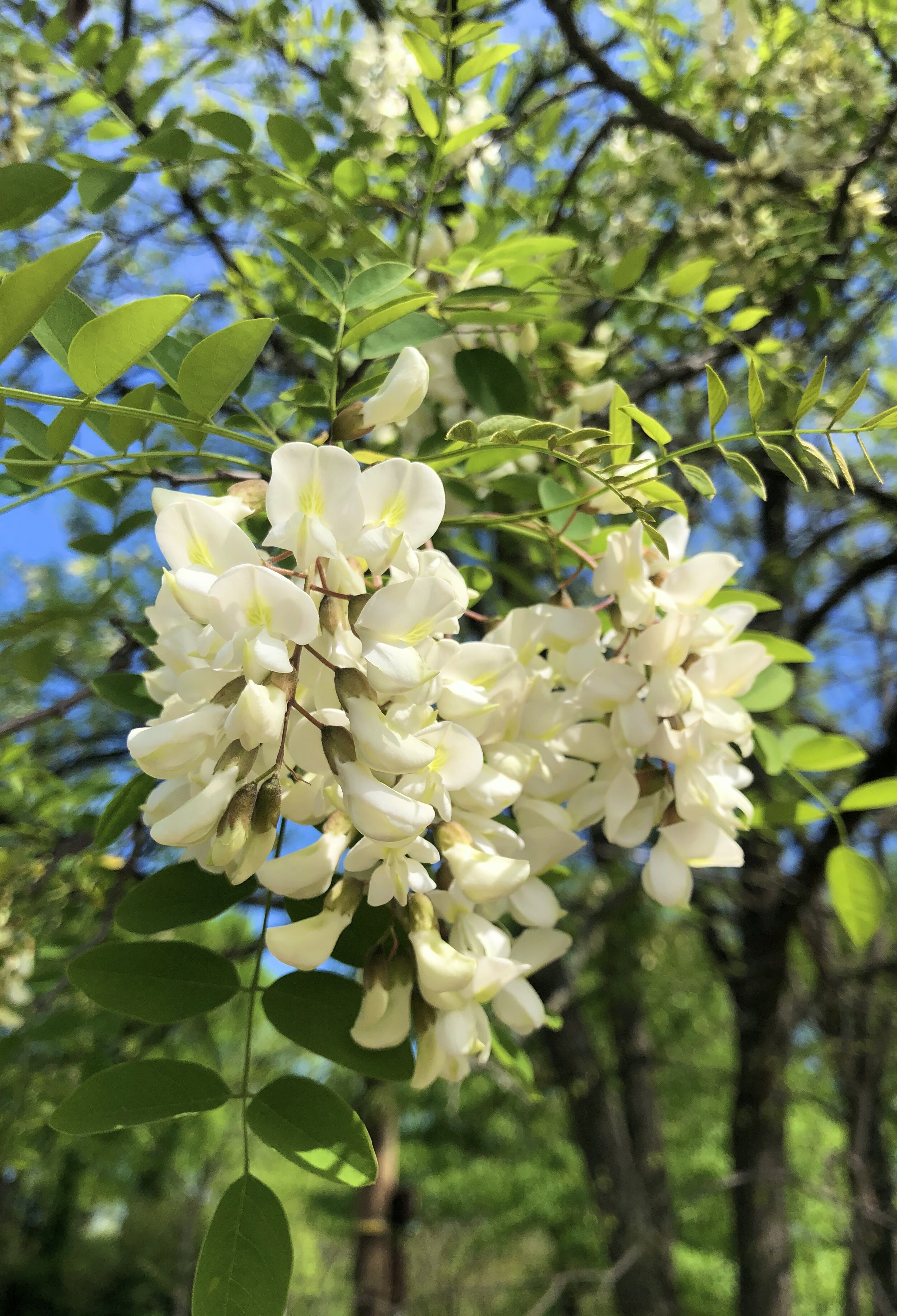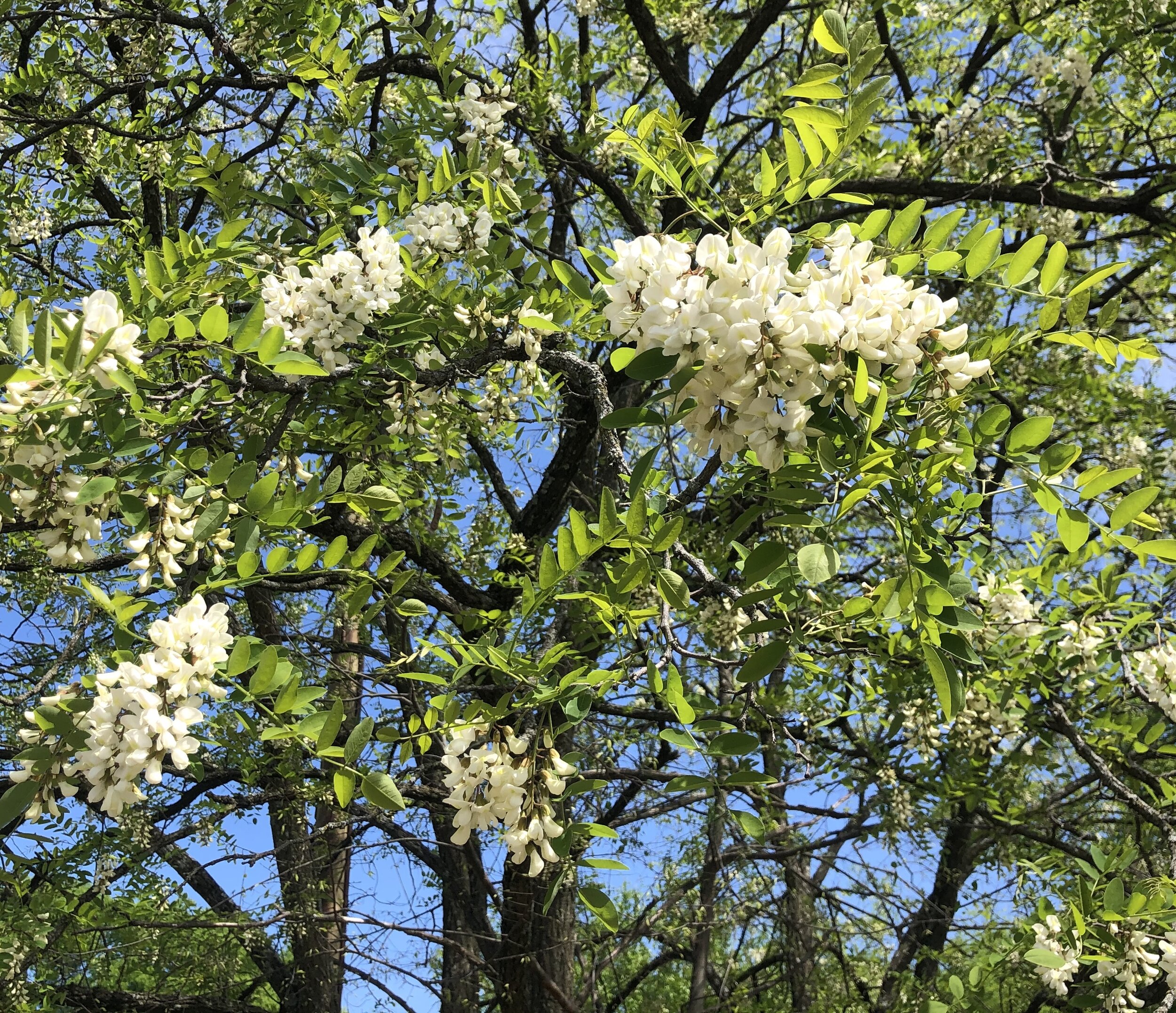Black Locust, Birthdays, and Phenology
How does a bear know when it's time to hibernate, when does a migratory bird start its southward journey for the winter, or how does a tree know that it is finally safe to break bud in the spring? Plants and animals don't have calendars or watches but instead respond to environmental cues that signal when it is time to enter a different phase of their lives. For example, as temperatures cool in the fall, deciduous trees and shrubs transition to the dormant stage by losing their leaves and halt most physiological functions. The study of the timing of these changes is called phenology and while this may be a new word for some folks, observing phenology certainly is not. I have a fun story about phenology, perhaps you do as well, mine involves my birthday, a friend, and black locust trees.
Speaking of black locust, perhaps you have noticed they are currently in flower around Nashville, and while we consider it to be a native tree, the extent of its natural range is not exactly known. A member of the legume family (Fabaceae) black locust (Robinia pseudoacacia) has been planted for centuries, but often “escapes” from cultivation and spreads into nearby natural areas thus creating confusion about its native range. In urban areas, black locust is often found growing along roads as well as in parks and on unmanaged or vacant city lots. Love it or not, this tree has a strong will to survive and reproduce, and it does so through sexual and asexual means. It is this determination to live and reproduce that routinely earns the black locust headliner status on almost every “Trees to Avoid” list that’s produced. While I cannot deny that this recognition is warranted, I also cannot deny that black locust has and always will hold a special place in my heart.
In the mid 1990’s (ouch, that’s 25 years ago), I was an undergraduate student at the University of Tennessee (Go Vols!) majoring in horticulture. Through a study group, I became friends with a classmate, the following year we were roommates, and for the last 25 years, we have enjoyed a great friendship. This friend, who shall remain nameless, never could remember my birthday, and I could not understand why; I mean, how hard is it to remember a good friend’s birthday? It’s the same date every year, what’s the problem? Admittedly, I am one of those who possesses the ability to remember trivial facts, some would say “useless information”, like specific dates and birthdays; but my friend, well, not so much! Being a tree guy, my friend finally put two and two together and realized that black locust was always in flower on my birthday; this was true, not just in Knoxville, but Nashville as well where he moved to following graduation.
After graduation, I chose a different path and moved away from Tennessee to various places near and far. Nevertheless, year after year during the second week of May, I would be treated to a phone call, a voicemail, or text with this simple message, “…the black locusts are flowering so I wanted to wish you happy birthday”. In some years this greeting came before my big day, in other years it came after, and occasionally on my actual birthday. The timing was inconsequential, everyone loves hearing from a good friend, including me; what really mattered was that this yearly tradition of delivering a birthday greeting was tied to phenology, specifically the flowering of the black locust, and for a couple of tree guys, we thought that was pretty cool!
I am not exactly sure when this began, but at some point, my friend got better at remembering my actual birthday, probably with the help of his Outlook or Google calendar rather than the old reliable black locust flowers that had served him well since our college days. To be honest, I am not sure if the black locust continued to be an accurate reminder for my birthday during this time because after all, I was not in Tennessee. Well that was then and this is now. In 2017, I moved to Nashville (25 years of homesickness finally won out) but now I know for certain that for the last 3 years the black locusts have not been in flower on May 12th, and this year, they flowered a full one month earlier.
By now you are probably thinking who cares when the black locust flower? Well, we all should as this is not a trivial issue, it is just one example out of hundreds, probably thousands, where phenology of a plant species has been significantly altered. Recall from earlier that some phenological events are controlled by seasonal changes in temperature patterns and these patterns determine the type of climate for a specific region. (Please do not confuse climate with “weather”, weather is an event, like that random day in April when it snowed a little or when the daily high or low temperature was well above or below the normal high and low for that date.) These changes in temperature patterns is an example of the impacts of climate change and they are impacting and altering the life cycle of the black locust as well as many other plants and animals worldwide.
Researchers and their volunteers are documenting and measuring these phenological changes in an attempt to determine what impacts they are having on the distribution and population size of plants and animals, particularly those that are already threatened. One of these scientists is my good friend and former colleague at the Chicago Botanic Garden, Dr. Kay Havens. Dr. Havens is responsible for this really cool project called Project Budburst. If phenology interests you, I encourage you to check it out (budburst.org). Citizen scientists all across the country are collecting phenological data on a whole array of plant species. This science-based project and others like it are broadening our understanding of the impacts of climate change on the environment and you can join the effort.
Alas, the black locusts are in peak flower right now and it is not my birthday, it’s not even my birthday month but I am still enjoying this arboreal floral display. I even shared a laugh with my friend about “my birthday tree” which is no longer my birthday tree, I guess it’s time to find a new one. As you shelter at home, make time to take a walk outside, try to set aside any negative feelings you may have about black locusts and go observe some flowers up close. They are displayed in pendulous clusters comprised of numerous classic legume family flowers that are pure white with yellow pollinator guides. Upon closer inspection, I think you might be surprised by their beauty, and not just in appearance as the black locust flower possesses one of the sweetest fragrance of any spring flowering tree. It is shockingly pleasant and well worth a sniff.
I hope you enjoyed this short story about the black locust and my birthday, and hopefully you learned something new about phenology. Speaking of phenology and birthdays, I hope the next time your birthday comes around you will look and see what is going on with the trees and plants around you on that day. If you notice something specific about a plant’s stage in life, share it with us on social media using #ntfbirthdaybotany. Continue to monitor this event each year on your birthday, note any changes in the timing, but keep in mind, you have to observe the phenological event on the same plant and in the same location each year.
In closing, I want to give a birthday shout-out to my fellow Taurus’s; remember no matter what anyone says, we are always right! Happy Birthday, enjoy the black locust, and all of our spring flowering trees in this unusually impressive year for them!



